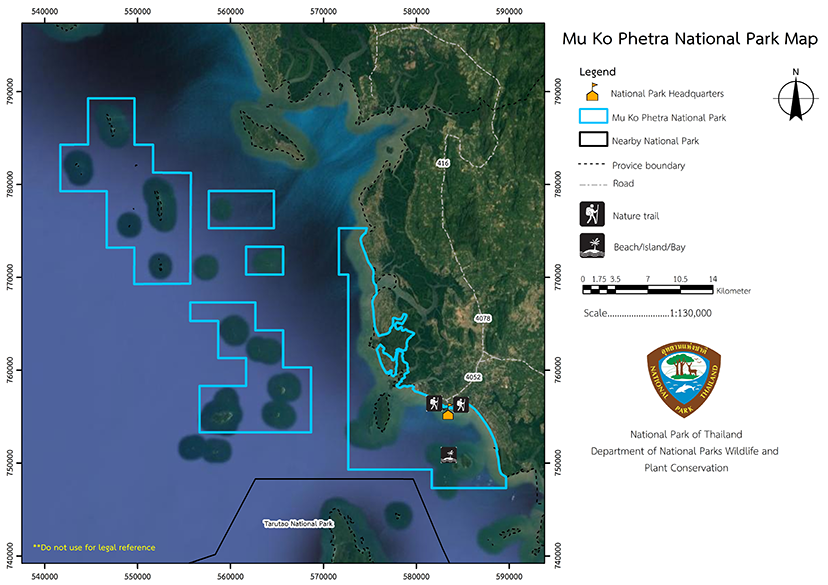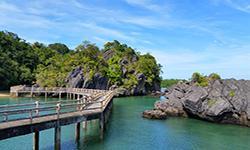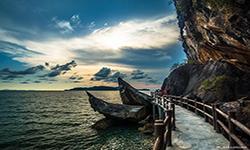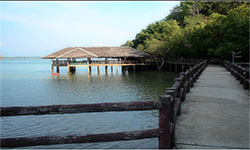Mu Ko Phetra National Park
Contact Location : Mu Ko Phetra National Park, 298 Moo 4, Pak Nam Sub-district, La-Ngu District, Satun Province 91110
Telephone Number : (+66) 7 474 0272
Email : phetra298@hotmail.co.th
Facebook : Mu Ko Phetra National Park
Information
-
Background
-
Note : After paying the entrance fee to the National Park, please carry the receipt for inspection.

308,987 rai (494.3792 square kilometers)
|
|
|
|
|
|
Nature trails ⇔ Observe flowers/plant ⇔ Bird , butterfly , wildlife watching activities ⇔ Take a boat ride or a paddle ⇔ snorkeling ⇔ Scuba diving ⇔ Take a photo/Video ⇔ Camping ⇔ Relax in a natural
Welfare shop : not available
National Park Headquarters : AIS, TRUE, DTAC
|
Mu Ko Phetra National Park consists of different topography with the sea, islands, mountains, and the plain in the valley and the coast. The coastal area has a 3 kilometers radius and is both flat and undulating, with mountains and capes including cliffs, rocky beaches, bays, and dunes. There are 22 islands that run on a North South axis. The limestone islands have caves or sinkholes as well as slope gradients of over 35%. There are burrows, caves, dolines, tower karsts and cliffs caused by the erosion of the wind and tides and the chemical erosion from rain. There are a few plains in the valleys, but they are short. There are also narrow beaches along the island's headlands and bays, mostly on the eastern side of the island.
|
|
Mu Ko Phetra National Park has a tropical monsoon climate and the weather conditions are similar throughout the year, In rainy season, from May to November, it rains a lot, and in summer it is hotter and rains a bit less.
|
|
|
|
The Limestone Forest is the most common in Mu Ko Phetra National Park and it is home to plant species that are similar to those in the understory layer of dry evergreen forests. There are no trees from the rubber families. In some areas, trees defoliate during the dry season. The plant species found include Streblus ilicifolius (Vidal) Corner, Toona febrifuga, Toona sureni (Blume) Merr., Cyathocalyx sumatrana Scheff. and Hydnocarpus ilicifolius. The tropical rain forest is the evergreen forest found on Ko Bulon Le, a large island with high humidity and slopes with low gradients. The forest has been encroached on for cultivation and tourism in some areas. The dominant plants are from the rubber family, such as Diospyros wallichii King & Gamble, Dipterocarpus grandiflorus (Blanco) Blanco, Semecarpus curtisii King, Ficus vasculosa Wall. ex Miq. Other trees include Palaguium obovatum, Gardenia thailandica Tirveng, Knema furfuracea (Hook.f. & Thomson) Warb., Xanthophyllum lanceatum (Miq.) J.J.Sm., Pterocymbium tinctorium (Blanco) Merr., Dipterocarpus costatus Gaertn.f. The ground plants consist of Bouea oppsitifolia, Paper Mulberryand Gardenia thailandicaTirveng, Knema laurina (Blume) Warb., Dipterocarpus costatus Gaertn. f., Dipterocarpus grandiflorus (Blanco) Blanco, Purple Millettia, Calameae and Caryota urens. A "beach forest" is a deciduous forest that appears along the sandy beachesand it is home to plant species that can withstand saline soil, brackish water, and salty sea spray. They consist of Derris indica (Lamk.) Benn., Terminalia catappa, Cordia subcordata Lam., Thespesia populnea (L.) Sol. ex Corrêa, and Asiatic mangrove. The ground plants are grass, Trianthema triquetra Rottler & Willd., and Goat's Foot Creeper. The mangrove swamp forest appears in tidal areas along the coast and estuaries where the soil is mainly mud. The plant species include Rhizophora apiculata, Rhizophora mucronata, Brownlowia peltata Benth., Sonneratia caseolaris (L.) Engl., Xylocarpus granatum Koenig, Xylocarpus moluccensis (Lam.) M. Roem., and Thespesia populnea (L.) Sol. ex Corrêa. The tree density is approximately 176–296 tons/rai and the species diversity is relatively low. Wildlife Mu Ko Phetra National Park has a low levels of wildlife diversity as they are relatively distant islands and only small land areas, which are covered with limestone forests that lack fresh water. Only a few animals live or have lived there, including the Mouse Deer, Wild Boars, and Palm Civets. Ko Bulon Le is the only island that contains a tropical rain forest, and as such is home to large trees that form a habitat for many birds, such as Great Hornbills and Oriental Pied Hornbills. Currently, the forest is being encroached upon by agriculture and tourism, so wildlife habitats and food sources, especially local fruits, have decreased, which has led to a reduction in species such as the Nicobar Pigeon, the Pied Imperial Pigeon, and Lyle's Flying Fox. The Nicobar Pigeon is currently listed asendangered. The encroachment has had a detrimental effect on lowland wildlife habitats, as well as a significant reduction in local fruit varieties. The fruit is the primary food source for three of the island's endemic wildlife species: the Chapi Bird, the White Plume, and the Island Hen Bat. The Chapi bird in particular is a threatened wildlife species. |
How to get there by car :
Traveling to Mu Ko Phetra National Park from Bangkok along Highway No. 4 and then take Highway No. 41 to Phatthalung Province. In Phatthalung rejoin Highway No. 4 and in Rattaphum District, Songkhla Province take Highway No. 406 and then turn right onto Highway No. 4137, which passes through Khuan Kalong District, Satun Province. Then turn right onto Highway No. 416, and at the milestone No. 6–7, turn left along the road to Ban Talo Sai, which is about 1.4km from the Mu Ko Phetra National Park Headquarters. It is located in the Ao Nun, Moo 4, Ban Talo Sai, Pak Nam Sub-district, La-Ngu District, Satun Province, 7km away from La-Ngu District about 56 kilometers from Satun Province.
Another route uses Highway No. 41 through Thung Song District, Nakhon Si Thammarat Province, then turns right onto Highway No. 403 and Highway No. 4 to Trang Province, passing through Yantakhao District along Highway No. 404 and turning left before the Palian District to Highway No. 416 and the Mu Ko Phetra National Park
National Park Ranger Station Pho To No. 1 (Khao To Ngai)
National Park Ranger Station Pho To No. 2 (Ko Lidi)
Accommodation : Phetra 101/1 (Thio Son)
Phetra 101/2 (Thio Son)
Phetra 101/3 (Thio Son)
Phetra 101/4 (Thio Son)
Phetra 103 (Bu Lon Mai Pai)
Mu Ko Phetra National Park offers lodges and camping grounds, including tents, equipment rental services, as well as restaurants



